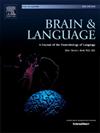面部线索可预测性的神经机制以及在母语和非母语重音单词中面部和声音线索的整合
IF 2.3
2区 心理学
Q1 AUDIOLOGY & SPEECH-LANGUAGE PATHOLOGY
引用次数: 0
摘要
本研究通过操纵面部线索对说话者口音的可预测性(可预测的:一种口音(美国口音或中国口音),不可预测的:两种口音(美国口音和中国口音),来检验面部线索与母语和非母语英语口音的整合。单语听众首先熟悉每个说话者的口音数量和类型。然后,他们完成了一项脑电图记录的听觉“去/不去”动物决策任务,其中不去的项目是关键词和非词。听众在演讲开始前和演讲同时看到了面部提示(说话者图像)。言语前ERP结果显示,听者对面部线索的处理基于面部线索的可预测性。言语后ERP分析发现,N400词汇量对母语语音有影响,而对非母语语音有影响。在纯音频实验中没有发现N400效应。这表明单语听者在实时非母语口音语音处理过程中整合了面部线索和听觉线索,而在实时母语口音语音处理过程中则没有。本文章由计算机程序翻译,如有差异,请以英文原文为准。
Neural mechanisms of face cue predictability and the integration of facial and acoustic cues in native- and nonnative-accented words
This study examined the integration of face cue and native- and nonnative-accented English speech by manipulating the face cue predictability of a speaker’s accent (predictable: one accent (American-accent or Chinese-accented), not predictable: two accents (American-accented and Chinese-accented). Monolingual listeners were first familiarized with each speaker’s number and type of accent(s). Then, they completed an EEG-recorded auditory go/no-go animal decision task where the no-go items were critical words and nonwords. Listeners saw a face cue (speaker image) before speech onset and concurrently with the speech. Pre-speech ERP results revealed that listeners processed face cues differently based on face cue predictability. Post-speech ERP analyses revealed N400 lexicality effects for native-accented speech, and face cue predictability effects for nonnative-accented speech. No N400 effects were found for an audio-only experiment. This indicates that the monolingual listeners integrate face cues and auditory cues during real-time nonnative-accented speech processing, but not during native-accented speech processing.
求助全文
通过发布文献求助,成功后即可免费获取论文全文。
去求助
来源期刊

Brain and Language
医学-神经科学
CiteScore
4.50
自引率
8.00%
发文量
82
审稿时长
20.5 weeks
期刊介绍:
An interdisciplinary journal, Brain and Language publishes articles that elucidate the complex relationships among language, brain, and behavior. The journal covers the large variety of modern techniques in cognitive neuroscience, including functional and structural brain imaging, electrophysiology, cellular and molecular neurobiology, genetics, lesion-based approaches, and computational modeling. All articles must relate to human language and be relevant to the understanding of its neurobiological and neurocognitive bases. Published articles in the journal are expected to have significant theoretical novelty and/or practical implications, and use perspectives and methods from psychology, linguistics, and neuroscience along with brain data and brain measures.
 求助内容:
求助内容: 应助结果提醒方式:
应助结果提醒方式:


